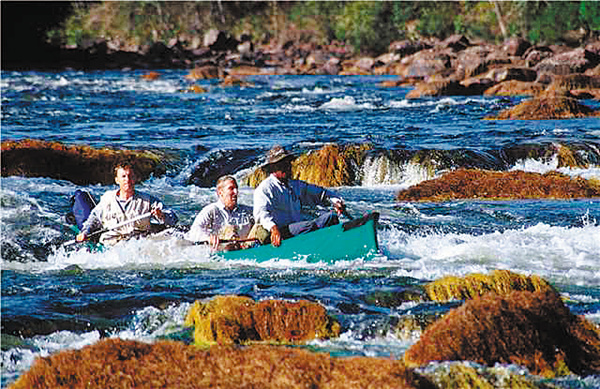

The River
Fawcett called the Rio Verde 'The Poisoned Hell'. After two days or so of easy paddling he hit rapids, dumped his canoe and decided to walk. The riverside vegetation was so tangled that his men could carry little more than their hammocks, their guns and the theodolites they used for mapping their route. A type of weed in the river made the water taste foul. Game and fish were nonexistent. For nearly two months, Fawcett and his team (two Britons and six local porters) subsisted on palm hearts and chonta nuts. They nearly starved.
Paddling and dragging our boat upstream for three days, we soon understood why Fawcett had felt trapped by the Verde. The river runs between canyon walls, hundreds of feet high. Once committed to following it, we could only go forward or back. Occasionally we saw spider monkeys traversing the cliff faces, clambering up with comparative ease to a top that was as unreachable for us as it had been when Fawcett had followed exactly the same route. We made it as far as the fifteenth rapid, a tumbling triple waterfall where the river dropped 10 meters in about eight times that distance. 'Cachoeira 15', as Fawcett noted it in his log had some significance, I am sure. It was only one of three points on the Rio Verde on a handwritten summary sheet of coordinates that I found in the archives of the Royal Geographical society in London before setting off on the trip. Was Cachoeira 15 the point where the decision was made to abandon the boat?
By now we were hemmed in by rock walls. We could not face hauling the canoe up more rapids and our forays on foot were blocked about half a mile upstream where the cliffs met the water. We made the decision to go back. We had no backup and no border to map unlike Fawcett back in 1908. We knew from reading his notes that the way ahead would only get harder. When he reached the Verde's source, he found his way blocked. One of the porters lay down and said he would rather die than carry on. Fawcett jabbed him in the ribs with a knife and made him get up. He forced his party to the top and, at last, had a lucky break, a deer sighted at the limit of his rifle's range. He managed to down it with a lucky shot. The morale boost from eating this gave everyone the impetus to continue.
From our travels up the Rio Verde and crossing the Serra Ricardo Franco plateau, we had no doubt that Conan Doyle had used Fawcett's descriptions in his novel, The Lost World. True, Roraima in Venezuela looked like the fictional plateau but with the on-the-ground details, our case was compelling.
The author is a British writer, explorer and science teacher. His books includethe Explorers Wanted! series, of which Explorers Wanted! At the North Pole won a Blue Peter Book Award in 2006.
(This is the second in a series of films that have undertaken together looking at the connection between early twentieth century fiction and exploration. The first "Where is Shangri-La" was published by China Daily in 2019 and went on to win a number of international awards and featured in film festivals around the world. Simon's series of books called Explorers Wanted have been translated into Chinese.)